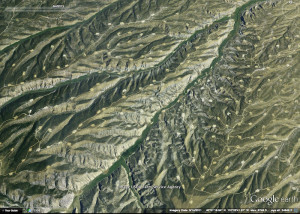 Editor’s note: this op-ed from the activists at Utah Physicians for a Healthy Environment covers the issue of air quality in the Uintah Basin of northeastern Utah, where a boom in fracking and oil drilling has led to more than 10,000 wells being drilled in the last decade or so. We’ve covered these issues in the past. We invite all who are concerned about this issue to join the opposition, which needs to begin with grassroots opposition work. Other strategies could also be considered.
Editor’s note: this op-ed from the activists at Utah Physicians for a Healthy Environment covers the issue of air quality in the Uintah Basin of northeastern Utah, where a boom in fracking and oil drilling has led to more than 10,000 wells being drilled in the last decade or so. We’ve covered these issues in the past. We invite all who are concerned about this issue to join the opposition, which needs to begin with grassroots opposition work. Other strategies could also be considered.
Two weeks ago the local Vernal newspaper published this Op Ed that basically minimized the health consequences of Vernal’s air pollution and the possible connection to a serious rise in infant deaths. You may read it here: http://www.ubmedia.biz/…/article_2c61a844-1ea3-11e5-a1a3-33…
As you might guess we strongly disagreed, and submitted an Op Ed that the Uinta Basin Standard refused to print, which is typical of their reporting bias. Below is our Op Ed. We encourage you to contact the editor, Kevin Ashby at: kevin <kashby@ubmedia.biz> and ask him why, when babies are still dying, he refuses to tell both sides of the story.
Last week the Standard published an Op Ed by Seth Lyman on air pollution and health. On behalf of the 375 physicians and other health care professionals of the Utah Physicians for a Healthy Environment (UPHE) we wish to respond.
Utah physicians formed UPHE, not because we were looking to promote a political agenda, but because we were concerned that, throughout the state, the public health consequences of air pollution were not well understood by Utah policy makers. Mr. Lyman’s Op Ed is a good example of that misunderstanding.
Mr. Lyman is an air quality scientist–studying how pollution is formed, distributed, and mitigated. He is not an expert on the health consequences of air pollution. We are. Every week for the last eight years we have diligently reviewed the worldwide medical literature on air pollution, including thousands of studies. No other entity in the state, including the Health Department and the Division of Air Quality does that on anywhere near that scale. Few organizations in the country have done that. We have no conflicts of interest, no employers to placate. We volunteer our time and donate our own money to this effort only because we are compelled by the science and believe in protecting our patients.
The medical literature is definitive–air pollution harms fetal development, and kills a surprisingly large number of people, including infants and babies in utero. The World Health Organization estimates one in eight deaths worldwide is due to air pollution. As physicians, those grim statistics become very personal, they represent real people, real patients, real lives lost or impaired.
Mr. Lyman leans on the Health Depart’s “study” (which didn’t involve physicians) to claim that there is no increased incidence of stillbirths or poor pregnancy outcomes in Vernal. Statistics can be created to say many different things, depending what data is used. If there is a spike in infant deaths in a certain location, that spike can be masked by including other locations. If there is a spike during a handful of years, that spike can be diluted by including many more years that were not under suspicion. Both of those techniques were used in the Health Depart. study. Nonetheless, Mr. Lyman is not correct. The Health Depart did acknowledge the spike of perinatal deaths, which began in 2010, peaked in 2013 (reaching six times the national rate), and is still on pace to be two to four times the national rate for 2015.
Mr. Lyman worries that keeping this issue alive “will only serve to aggravate the suffering of those who have experienced stillbirth or other health problems.” Yet by endorsing the Health Dept’s analysis he resurrected their clumsy attempt to invoke bad personal behavior on the part of pregnant Vernal mothers–smoking, drinking, drugs, poor nutrition, economic stress, or lack of prenatal care–as possible explanations. There’s no evidence for pregnant mother “misbehavior” in Vernal. But the suggestion that “we don’t want to stress pregnant mothers out about Vernal air pollution, instead we’ll blame them for a presumed lack of personal discipline” is a strange way to help them avoid stress.
Lyman down plays the Basin’s periodic high levels of ozone and particulate matter, claiming that Basin air is usually cleaner than Salt Lake’s. That’s a very low bar. Salt Lake is consistently ranked one of the worst cities in the country for acute spikes in particulate pollution. But that comparison is also misleading. Ozone and particulates are certainly hazardous, but they are not as toxic as VOCS (volatile organic compounds like benzene, toluene and xylene). A study by the U. of Colorado in the winter of 2012 and 2013 found shocking levels of VOCs in the Basin, as high as what would be generated by 100 million cars, eight times more than all the cars in Los Angeles. Because VOCs aren’t regulated by the EPA, public officials think they can ignore it. But make no mistake, this is a genuine pollution nightmare–to our knowledge, unequaled anywhere else in the country.
Wherever you have a pollution nightmare, if you look for it, you will find a public health nightmare. For the most precious and vulnerable residents of the Uinta Basin, honestly addressing the air pollution could be a matter of life and death.
